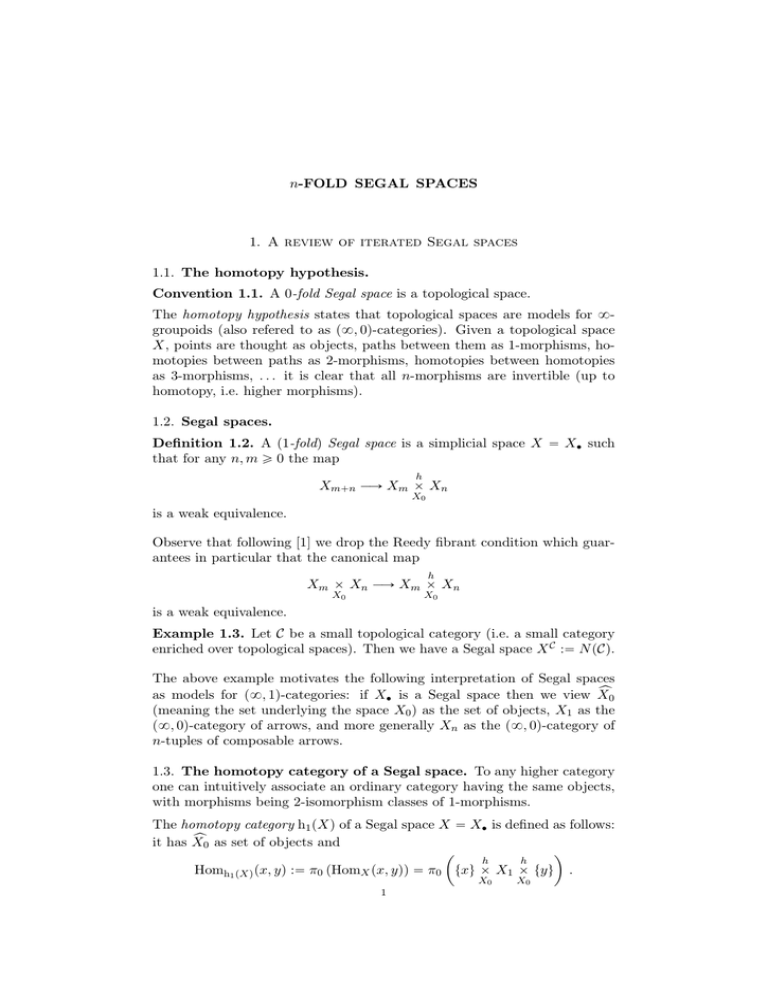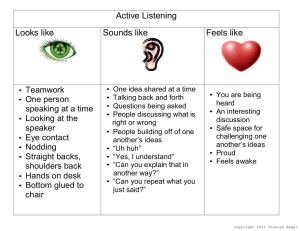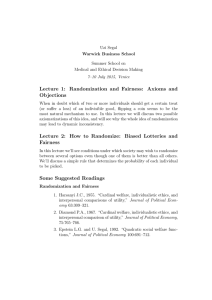n-FOLD SEGAL SPACES 1. A review of iterated Segal spaces 1.1
advertisement

n-FOLD SEGAL SPACES
1. A review of iterated Segal spaces
1.1. The homotopy hypothesis.
Convention 1.1. A 0-fold Segal space is a topological space.
The homotopy hypothesis states that topological spaces are models for 8groupoids (also refered to as p8, 0q-categories). Given a topological space
X, points are thought as objects, paths between them as 1-morphisms, homotopies between paths as 2-morphisms, homotopies between homotopies
as 3-morphisms, . . . it is clear that all n-morphisms are invertible (up to
homotopy, i.e. higher morphisms).
1.2. Segal spaces.
Definition 1.2. A (1-fold) Segal space is a simplicial space X “ X‚ such
that for any n, m ě 0 the map
h
Xm`n ÝÑ Xm ˆ Xn
X0
is a weak equivalence.
Observe that following [1] we drop the Reedy fibrant condition which guarantees in particular that the canonical map
h
Xm ˆ Xn ÝÑ Xm ˆ Xn
X0
X0
is a weak equivalence.
Example 1.3. Let C be a small topological category (i.e. a small category
enriched over topological spaces). Then we have a Segal space X C :“ N pCq.
The above example motivates the following interpretation of Segal spaces
x0
as models for p8, 1q-categories: if X‚ is a Segal space then we view X
(meaning the set underlying the space X0 ) as the set of objects, X1 as the
p8, 0q-category of arrows, and more generally Xn as the p8, 0q-category of
n-tuples of composable arrows.
1.3. The homotopy category of a Segal space. To any higher category
one can intuitively associate an ordinary category having the same objects,
with morphisms being 2-isomorphism classes of 1-morphisms.
The homotopy category h1 pXq of a Segal space X “ X‚ is defined as follows:
x0 as set of objects and
it has X
ˆ
˙
h
h
Homh1 pXq px, yq :“ π0 pHomX px, yqq “ π0 txu ˆ X1 ˆ tyu .
X0
1
X0
2
N -FOLD SEGAL SPACES
The composition of morphisms is defined as follows:
˙
˙ ˆ
ˆ
h
h
h
h
h
h
h
ÝÑ txu ˆ X1 ˆ X1 ˆ tzu
txu ˆ X1 ˆ tyu ˆ tyu ˆ X1 ˆ tzu
X0
X0
X0
X0
X0
X0
h
h
X0
X0
h
h
X0
X0
X0
ÐÝ
˜ txu ˆ X2 ˆ tzu
ÝÑ txu ˆ X1 ˆ tzu .
The second arrow happens to go in the wrong way but it is a weak equivalence, and thus it induces an isomorphism on π0 .
1.4. Complete Segal spaces. In our definition of the homotopy category
h1 pXq of a Segal space X “ X‚ , as well as in our interpretation of X as
an p8, 1q-category, we do not seem to use the information coming from the
topology of X0 .
Loosely speaking, we would like to see the topology of X0 as encoding the
8-groupoid of invertible arrows in our p8, 1q-category. We will say that a
element f P X1 (an arrow) is invertible if its image through
ˆ
˙
h
h
h
h
txu ˆ X1 ˆ tyu ÝÑ txu ˆ X1 ˆ tyu ÝÑ π0 txu ˆ X1 ˆ tyu “ Homh1 pXq px, yq ,
X0
X0
X0
X0
X0
X0
where x and y are source and target (i.e. the two faces) of f , is an invertible
morphism in h1 pXq.
Let us denote by X1inv the subspace of invertible arrows, and observe that
the map X0 Ñ X1 factors through X1inv (because the image of an x P X0
through X0 Ñ X1 Ñ Homh1 pXq px, xq is idx ).
Definition 1.4. A Segal space is complete if the map X0 Ñ X1inv is a weak
equivalence. An p8, 1q-category is a complete Segal space.
Segal spaces can always be completed, therefore we we will not put to
much emphasis on the completeness condition unless this is strictly necessary.
1.5. n-fold Segal spaces.
Definition 1.5. An n-fold Segal space is an n-fold simplicial space X “
X‚,...,‚ such that
(i) For every 1 ď i ď n, and every k1 , . . . , ki´1 , ki`1 , . . . , kn ě 0,
Xk1 ,...,ki´1 ,‚,ki`1 ,...,kn
is a Segal space.
(ii) For every 1 ď i ď n, and every k1 , . . . , ki´1 ě 0,
Xk1 ,...,ki´1 ,0,‚,...,‚
1
is essentially constant .
1An m-fold simplicial space X
‚,...,‚ is essentially constant if there is a weak homotopy
equivalence of m-fold simplicial spaces Y Ñ X, where Y is constant.
n-FOLD SEGAL SPACES
oo
XO 00
O
oo
XO 10
O o
oo
o
XO 20
O o
o
XO O11O oo
o
XO O21O ooo
oo
X
O O 12
OO o
ooo
X
O O 22
OO o
3
˚
XO O01O oo
˚
oo
X
O O 02
OO
˚
Diagram of the 2-fold Segal space. Asterisks indicate weak
equivalences.
An n-fold Segal space is complete, if
(iii) For every 0 ď i ď n, k1 , . . . , ki´1 ě 0,
Xk1 ,...,ki´1 , ‚, 0, . . . , 0
is a complete Segal space.
We now explain how n-fold Segal spaces can be thought of as higher categories.
First of all, let’s try to understand condition (ii) in the definition of an n-fold
Segal space. For n “ 2 one can think of this as “fattening” the objects in a
bicategory:
ó
to
ó
where points are objects, i.e. elements in X0,0 , horizontal arrows are elements in X1,0 , which correspond to 1-morphisms, and the vertical arrows
are elements in X0,1 , which are essentially just identities because of condition (ii). The arrow in the face should be thought of as a 2-morphism which
is an element in X1,1 .
For n “ 3, the same idea works. Elements of X0,0,0 can be thought as being
objects of the category, elements of X1,1,0 as 1-morphisms and elements of
X1,1,1 as 2-morphisms.
In general, with higher morphisms, we should think of elements of X0,...,0
as the objects of our category, X1,...,1,0,...,0 as i-th “horizontal” arrows (i is
the number of 1’s), which correspond to the i-morphisms. Moreover, the
others are the “vertical” arrows, which are essentially just identities of lower
morphisms.
Here is how the diagram of a 3-fold Segal Space looks like.
4
N -FOLD SEGAL SPACES
˚
X020
O O jj
˚
j
X120
OO j
X010
O O jj
j
˚
X000
O O jj
˚
j
j
˚
j
X200
O O jj
XO 021
O O jj
˚
XO 011
O O jj
j
˚
j
XO 121
OO j
˚
j
˚
XO 001
O O jj
j
XO 111
O O jj
˚
j
j
˚
j
XO 201
O O jj
XO 022
O O O jj
j
˚
XO 012
O O O jj
˚
j
XO 122
OOO j
˚
j
˚
j
XO 211
O O jj
j
XO 101
O O jj
˚
j
XO 221
O O jj
˚
˚
j
X210
O O jj
j
X100
O O jj
˚
j
X220
O O jj
j
X110
O O jj
˚
j
XO 112
OOO j
XO 002
O O O jj
j
˚
j
j
XO 212
O O O jj
j
XO 102
OOO j
˚
j
XO 222
O O O jj
˚
j
j
j
XO 202
O O O jj
˚
j
Diagram of the 3-fold Segal space. Asterisks indicate weak
equivalences.
n-FOLD SEGAL SPACES
5
We will now describe several constructions that someone would like to be
able to do when dealing with models of higher categories.
1.6. Truncation. Given an p8, nq-category, its p8, kq-truncation (k ď n)
is the p8, kq-category obtained from it by discarding the non-invertible mmorphisms for k ă m ď n.
In terms of iterated Segal spaces, if X “ X‚,...,‚ is an n-fold Segal space then
its p8, kq-truncation is the k-fold Segal space
τk X “ X‚, . . . , ‚,0, . . . , 0 .
loomoon loomoon
k times
n´k times
Note that if X is complete then so is τk X by condition (3).
For example, in the diagram of the 2-fold Segal space, τ1 X is the upper line
- we lose all informations regarding the 2-morphisms. In the diagram of the
3-fold Segal space, τ1 X is the upper face of the cube and τ2 X is the edge
containing X0,0,0 , X1,0,0 , X2,0,0 , . . .
Warning 1.6. Truncation does not behave well with completion. We should
ALWAYS complete an n-fold Segal space before truncating it, otherwise the
categorical interpretation of truncation fails: e.g. if X “ X‚ is a (1-fold)
Segal space then X0 does not identify with the 8-groupoid of invertible
morphisms unless X is complete.
1.7. Extension. Any p8, nq-category can be viewed as an p8, n`1q-category.
In terms of iterated Segal spaces, any n-fold Segal space can be viewed as
a constant pn ` 1q-fold Segal space. We call ε the extension functor, which
is left adjoint to τ1 . Moreover, the unit id Ñ τ1 ˝ ε of the adjunction is the
identity.
1.8. Iterated Segal spaces of morphisms. Given two objects x, y in an
p8, nq-category we would like to have an p8, n´1q-category of morphisms
from x to y.
Let X “ X‚,¨¨¨ ,‚ be an n-fold Segal space. As we have seen above one should
{
think of objects as elements in the set X
0,...,0 . The pn´1q-fold Segal space
{
of morphisms between two given objects x, y P X
0,...,0 is
HomX px, yq‚,¨¨¨ ,‚ :“ txu
h
ˆ
X0,‚,¨¨¨ ,‚
X1,‚,¨¨¨ ,‚
h
ˆ
X0,‚,¨¨¨ ,‚
tyu .
Sanity check 1.7 (Compatibility with extension). Let X be a topological space (an p8, 0q-category), viewed as a constant Segal space X‚ (an
p8, 1q-category). For any two objects x, y P X0 “ X the topological space
(i.e. p8, 0q-category) of morphisms from x to y is
h
h
h
X0
X0
X
HomX‚ px, yq :“ txu ˆ X1 ˆ tyu “ txu ˆ tyu “ PathX px, yq ,
as expected.
6
N -FOLD SEGAL SPACES
1.9. The homotopy bicategory of a 2-fold Segal space. To any higher
category one can intuitively associate a bicategory having the same objects
and 1-morphisms, and with 2-morphisms being 3-isomorphism classes of the
original 2-morphisms.
The homotopy bicategory h2 pXq of a 2-fold Segal space X “ X‚,‚ is defined
y
as follows: it has X
0,0 as set of objects, and
˙
ˆ
`
˘
h
h
Homh2 pXq px, yq “ h1 HomX px, yq “ h1 txu ˆ X1,‚ ˆ tyu
X0,‚
X0,‚
as Hom categories. The horizontal composition is defined as follows:
˙
˙ ˆ
ˆ
h
h
h
h
h
h
h
ÝÑ txu ˆ X1,‚ ˆ X1,‚ ˆ tzu
txu ˆ X1,‚ ˆ tyu ˆ tyu ˆ X1,‚ ˆ tzu
X0,‚
X0,‚
X0,‚
X0,‚
X0,‚
X0,‚
h
h
X0,‚
X0,‚
h
h
X0,‚
X0,‚
ÐÝ
˜ txu ˆ X2,‚ ˆ tzu
ÝÑ txu ˆ X1,‚ ˆ tzu .
The second arrow happens to go in the wrong way but it is a weak equivalence. Therefore after taking h1 it turns out to be an equivalence of categories, and thus to have an inverse (assuming the axiom of choice).
References
[1] J. Lurie, On the Classification of Topological Field Theories, Current developments
in mathempatics, 2008, 129–280, Int. Press, Sommerville, MA, 2009. Available at
http://www.math.harvard.edu/~lurie/papers/cobordism.pdf.
X0,‚

